Interpretive Signage at Cheaha State Park: Enhancing Nature Appreciation through Knowledge
Okay, time for the fifth of these Cheaha-themed Great Blue Heron Blog Posts from my mid-October visit to Alabama’s highest point. I believe fundamentally that every lesson for living, learning, serving, and leading is either written indelibly in Nature or is powerfully inspired by Nature. I incorporated that conclusion and its life-guiding forces throughout my first two books: Nature Based Leadership and Nature-Inspired Learning and Leading. I carry the theme forward in Weaned Seals and Snowy Summits: Stories of Passion for Place and Everyday Nature, which should see published daylight by mid-2019. Perhaps about the same time, my Harnessing Nature’s Wisdom and Power for Life and Living will be available. Meantime, I will offer Nature’s lessons piecemeal through these Blog Posts.
The message I offer today is that knowledge, wisdom, and appreciation fuel my own passion for Earth stewardship and aid in seeing and interpreting Nature’s guidance for life and living. I am able to read and translate Nature’s language on the bases of: a lifelong love affair and intimate relationship with wildness; bachelors and doctoral level education, respectively, in forestry and applied ecology; and nearly four decades of applied research and practice in natural resources study and management. I bring my science knowledge and emotional embrace of Nature to bear in writing about Nature’s principles, tenets, and lessons.
Cheaha State Park does its part in helping Park visitors understand, appreciate, and accept their obligation to Earth stewardship via some of the most exquisite interpretative signage I have encountered anywhere in Nature. So view this Post as a quick tour of Cheaha through a portfolio of the Park’s signage. Unlike nearly every other Blog Post, most of the formal images below (the 13 with the green banner and message fully contained in the image) are official State Park master images. The photo below is mine taken on-site of one of the official signs mounted and in-place.
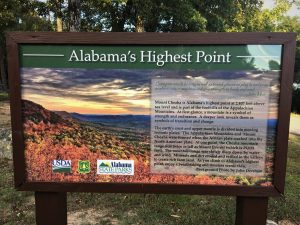
Likewise, this is my photo of the wood-routered Bald Rock ADA-Accessible Trail entrance.
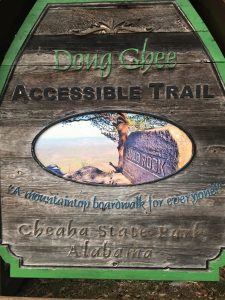
And this the first of the official sign images. What better place to begin than with reference to the human occupants who lived within this mountain terrain for 15 millennia prior to European settlement?

Mount Cheaha does not stand isolated and separate from the forests, peaks, and valleys surrounding it. The ecosystem extends across and beyond the Talladega National Forest.
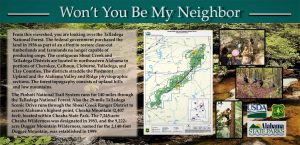
The story of Cheaha shifts to the tale of European settlement; the official image and my photo of the sign on-site.
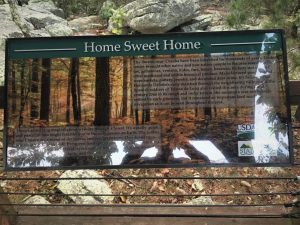
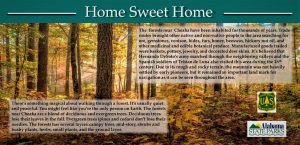
Humans account for only a small cross-section of life in these mountains.
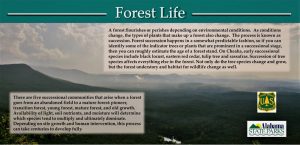
Forest harvesting and wood products manufacturing have played huge roles in the cultural and economic vitality of these hills and valleys for the past 200 years.
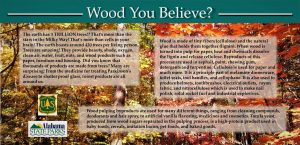
I’m impressed by a thread of history common to all the Alabama State Parks I’ve visited. The Park chronicles and celebrates the significant role the 1930s Civilian Conservation Corps played in establishing Cheaha State Park infrastructure. The CCC built to last (and that’s not just a slogan or tag line… and so much of the stonework stands in its original splendor some 80 years later.
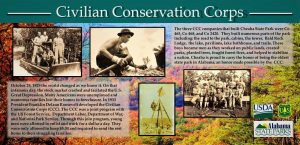

The same thread weaved through the story of Maryland’s State Parks and State Forests, where I worked all three of my undergraduate summers. The CCC did incredible, lasting work, ushered a generation of young men into adulthood, and serendipitously helped pre-position a nation for an inevitable world war.
Forest ecology is a complex, interdependent network of relationships, geophysical weathering, and geochemical interactions. The carbon cycle is just one element of this extraordinary symphony of life.
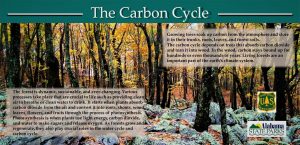
Insects, microorganisms, and non-flowering plants accomplish much of the carbon cycle’s essential processes.
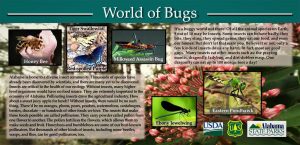
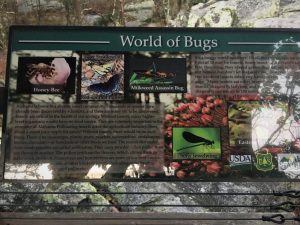
Among the most robust and ubiquitous non-flowering plants — the lichens. They aggressively and persistently seem to colonize every square inch of exposed tree bark and bare rock surface. The old saw, Nature abhors a vacuum, is not some flight of fancy. Instead, Nature establishes life wherever opportunity presents a niche to colonize.
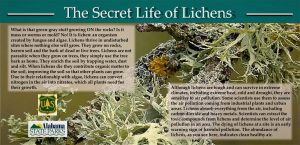
We see and admire the Mighty Oak, which I’ll refer to as charismatic mega-flora. Too many of us pay scant attention to the “lesser” flora. But “lesser” to what degree? There is nothing scant about what lichens, mosses, ferns, and algae contribute to ecosystem function. Again, no niche in Nature goes unoccupied. Remember, Nature disdains vacuums. Perhaps more accurately, Nature simply does not recognize a vacuum.
Likewise, critters of many forms and function occupy select positions within the southern Appalachian ecosystem. Snakes, turtles, lizards are common across Cheaha and the Talladega.
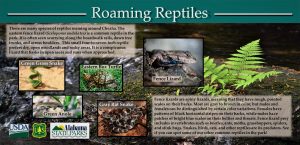
Same for mammals. I saw many deer and squirrels during our brief visit.
Ah, if only I could soar over Cheaha and the Talladega like our feathered masters of the sky: hawks, eagles, or vultures! What a thrill it would be to soar above the state’s highest point.
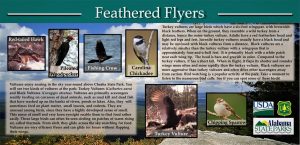
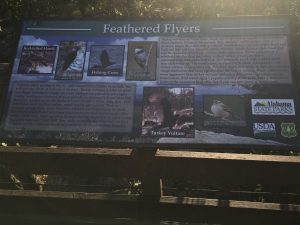
John Muir so beautifully observed, “When we try to pick out anything by itself, we find it hitched to everything else in the Universe.” And so it is with carbon and water — such richness of relationships within our southern forests.
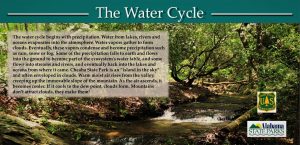
The Park’s signage makes clear that we have an obligation to responsibly tend our State Parks — to understand, appreciate, and enjoy these treasures. Aldo Leopold said with frustration 70 years ago in A Sand County Almanac, “All conservation of wildness is self-defeating, for to cherish we must see and fondle, and when enough have seen and fondled, there is no wilderness left to cherish.” Rather than view use (seeing and fondling) as inevitably synonymous with degradation, I hold firm that informed, responsible, and managed use can be accomplished without trace. I believe that we can use and cherish in a manner that retains equal quality and value for Park visitors of generations hence.
I like Cheaha’s Leave No Trace theme, including Big Foot’s role in spreading the message to kids of all ages!
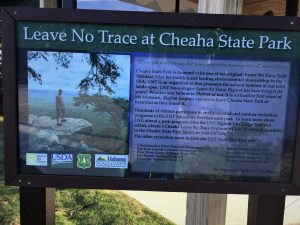
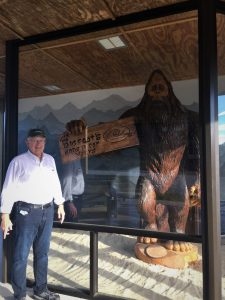
The outdoor seating (and messaging) below faces the Big Foot display case. The Park System recognizes that the best way to influence the future is through the eyes and awareness of today’s youth. 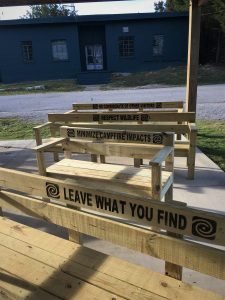
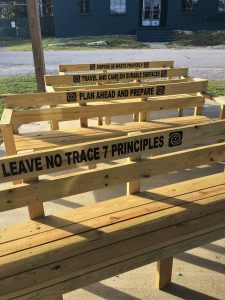
I applaud our Alabama State Parks for so effectively employing environmental education, a clear component of the Alabama State Parks’ mission: “To acquire and preserve natural areas; to develop, furnish, operate and maintain recreational facilities, and to extend the public’s knowledge of the state’s natural environment.” And one of the core Parks’ Goals: “To preserve unique natural features and integrity of state parks for future generations.” Extending knowledge and preserving natural features for future generations — the essence of leaving no trace and assuring that our natural heritage reaches seven generations hence… and beyond.
The Cheaha signage is superlative. The 22-pearl State Park necklace is our treasure to pass forward and tend forever. I commend Park leadership for taking their trust responsibility seriously. Well done!
Thoughts and Reflections
I wrote my two books (Nature Based Leadership (2016) and Nature-Inspired Learning and Leading (2017)) to encourage all citizens to recognize and appreciate that every lesson for living, learning, serving, and leading is either written indelibly in or is powerfully inspired by Nature. Here are four succinct lessons that apply to me with respect to this GBH Blog Post:
- Knowledge, wisdom, and appreciation fuel my own passion for Earth stewardship and aid in seeing and interpreting Nature’s guidance for life and living.
- I am able to read and translate Nature’s language on the bases of: a lifelong love affair and intimate relationship with wildness; bachelors and doctoral level education, respectively, in forestry and applied ecology; and nearly four decades of applied research and practice in natural resources study and management.
- I bring my science knowledge and emotional embrace of Nature to bear in writing about Nature’s principles, tenets, and lessons.
- I’ve learned that Nature’s lessons often must pass through a filter to argue their case and make an indelible mark on the recipient… young and more senior. The Cheaha signage serves as that filter and spark… lighting the beacon of understanding, appreciation, respect, and responsibility.
Subtle (and some not-so-subtle) education and awareness efforts can help Park users feel the Magic; sense the Wonder; embrace an Earth ethic; and pass the Torch. May Nature inspire all that you do!
Note: All blog post images created & photographed by Stephen B. Jones unless otherwise noted. Please circulate images with photo credit: “©2018 Steve Jones, Great Blue Heron LLC. All Rights Reserved.”
Another Note: If you came to this post via a Facebook posting or by an another route, please sign up now (no cost… no obligation) to receive my Blog Post email alerts: https://stevejonesgbh.com/contact/
And a Third: I am available for Nature-Inspired Speaking, Writing, and Consulting — contact me at steve.jones.0524@gmail.com



